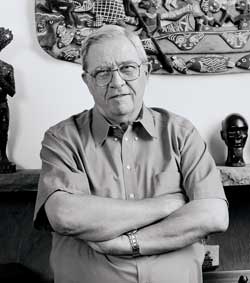|

Looking
Ahead in a New World
OAM examines the issues of a post-September
11 world.
As
2001 drew to a close, Afghan women were shedding their veils and
returning to work. The Taliban’s last stronghold was on the
verge of ruin, and the outline of a new power-sharing government
was nearing completion. In the aftermath of September 11, OAM found
Oberlin connections in key policy and health positions. Some are
framing our future; others are preventing past mistakes.
Viruses:
Conquerors of the Planet
When the first supply of smallpox vaccines arrives early this year,
thank D.A. Henderson for pushing the issue
by Doug McInnes ’70
 Daily
reports of anthrax infection last fall revived a dormant fear in
Americans about the deadliness of nature’s own biological agents.
Smallpox is perhaps mankind’s most lethal disease; it killed
more than 300 million people in the last century alone. Eradicated
in 1979 after a 12-year campaign orchestrated by the World Health
Organization (WHO), the virus survives today only in laboratories—in
theory. Daily
reports of anthrax infection last fall revived a dormant fear in
Americans about the deadliness of nature’s own biological agents.
Smallpox is perhaps mankind’s most lethal disease; it killed
more than 300 million people in the last century alone. Eradicated
in 1979 after a 12-year campaign orchestrated by the World Health
Organization (WHO), the virus survives today only in laboratories—in
theory.
The campaign was stunningly successful, but former WHO leader D.A.
Henderson ’50 has maintained for years that smallpox and other
infectious diseases could reemerge as weapons of mass destruction.
In 1998, he helped to found the Center for Civilian Biodefense Studies
at Johns Hopkins University, which embarked upon a lonely campaign
to convince a disinterested and resistant government of the grim
possibilities.
Despite periodic talk of bioterrorist attacks, few authorities considered
them a real threat. But, here and there, Henderson made inroads—attracting
the attention of infectious disease specialists, the CIA, the Department
of Defense, and some well-placed officials at the Department of
Health and Human Services. Then the World Trade Center fell.
“People started asking what the terrorists might do next,”
Henderson says. “By the following weekend, it began to dawn
on us that one of their avenues could be the use of bioweapons.”
The Bush administration and media reached the same conclusion, and
suddenly the country wanted to hear what Henderson and his tiny
biodefense center had to say. His quotes dotted pages of the The
New York Times and The Washington Post, and he was interviewed at
length by “60 Minutes’” host Mike Wallace. He was
called in for frequent consultations with Health and Human Services
Secretary Tommy Thompson and his staff.
On October 5, the first anthrax case was reported. Consultations
became more frequent and the pace of activity more frantic. At the
end of the month, Thompson appointed Henderson director of the new
Center for Public Health Preparedness.
“The bottom line is that there’s not much expertise on
bioterrorism matters in either the medical community or public health
institutions,” Henderson says. He and his colleagues have tried
to fill the vacuum. “We are a small group, but we do have a
lot of expertise. Unfortunately, in all of this there has been a
lack of information forthcoming from our government.”
A New Routine
Henderson rises each day at 5:30 a.m., often to travel from his
Baltimore home to Washington, where he may confer with Thompson
or other high-ranking Bush staff members. He arrives home between
6 and 9 p.m., greeted by 150 email messages. He’ll reply to
30, handing the rest off to someone else. Then there are the phone
calls. Henderson typically works until after midnight, beginning
his daily cycle less than six hours later. A glass of wine offers
an occasional respite. Before September 11, he exercised to unwind.
Now there is no time.
Henderson’s warning, delivered in a calm voice bordering on
monotone, is straightforward: terrorists have at their disposal
ancient deadly organisms, including smallpox, anthrax, botulism,
and plague. Among these, two stand out: the smallpox virus because
it is contagious, and anthrax bacteria because it is accessible,
stable, transportable, and easy to release.
Just 100 kilograms of anthrax released upwind of a large American
city would kill between 130,000 and 3 million people, depending
on the weather and other variables, Henderson estimates. He gave
that assessment to the Senate Foreign Relations Committee on September
5, just weeks before anthrax-laced letters were unleashed within
the mail.
Henderson says smallpox is more difficult to transport or release
into the air, “but if a smallpox epidemic were to start, it
would be a disaster.”
Smallpox acts like a chain letter; each victim is expected to pass
it on. To stop its spread, health officials must remove the next
round of potential hosts by vaccinating those who have been exposed
or who could be. Simple, in theory; a mammoth task in practice.
In 1947, a Mexican traveler carried smallpox into New York City,
where, to prevent a pandemic, health officials vaccinated 6.5 million
people. Smallpox released into today’s mobile population would
spread more widely and rapidly than 50 years ago. Routine vaccination
for Americans ceased in 1972, and those vaccinated before then have
most likely lost immunity. Moreover, eradication efforts were so
successful that large supplies of vaccine were deemed unnecessary.
As of September 11, there were 15 million doses on hand.
Fortunately, Henderson’s campaign for larger stockpiles caught
the attention of mid-level officials within the Clinton administration.
The government’s first order—40 million doses—was
placed in the year 2000 and will arrive early this year. In the
aftermath of the attack, the Bush administration increased the order—enough
for all Americans. That supply will arrive later.
“Biological weapons have been little used over the past century
with the exception of several incidents in China during the second
world war,” says Henderson. “Some people have asserted
that there was a moral bar below which people would not go. Others
believed it extremely difficult for any terrorist group to produce
biological weapons and make them useable. Many people had the feeling
that since this was something we hadn’t witnessed, it was therefore
unlikely.”
But smallpox has existed in the laboratories of several nations,
including the former Soviet Union, which had continued a massive
bioweapons program long after signing an international agreement
to stop. The Soviets were also suspected of creating mechanisms
to deliver the virus via warheads of intercontinental ballistic
missiles.
Who else might have or want bioterrorist weapons? In a report to
Congress, Henderson said at least a dozen countries have or are
seeking offensive biological weapons capabilities. The New Yorker
listed 10 such countries two years ago: Russia, China, India, Pakistan,
Israel, North Korea, Iraq, Iran, Cuba, and Serbia. Potential suppliers
abound, and U.S. officials fear that former Soviet bioweapons experts
are up for hire.
Because bioweapons are far easier to create than nuclear bombs,
terrorists find them appealing. Producing one kilogram of plutonium
requires 100 tons of uranium ore and an array of large, specialized
equipment. Bioweapons can be developed in a two-car garage with
equipment that can be ordered off the shelf from biotechnology supply
houses. And while a sizable plutonium operation could be spotted
aerially, a bioweapons facility can operate in anonymity. Once production
is completed, the facility can be disinfected within a day. No traces
would remain. Furthermore, agents are easily released in an aerosol
spray form, odorless and invisible. Only later, perhaps weeks later,
would people fall sick.
Dealing with such threats requires new technology and public health
strategies. Henderson suggests that microchip sensors be developed
to identify diseases quickly by decoding their genetic signature.
He also urges a speedy development of new antibiotics and antiviral
drugs and new ways to enhance human immune response.
Lorain County Medical Examiner Paul Matus ’72 is leading efforts
to improve preparations for a bioterrorism attack in Ohio. “If
smallpox hit the county tomorrow, we would be in very deep trouble,”
he says. “We have no vaccines here. We would have to scramble
to get people vaccinated—if we could get the vaccines.”
History illustrates what to expect if we fail to prepare. Smallpox
ravaged ancient Egypt in the time of the Pharaohs. The plague killed
one-third of Europe’s population in the 14th century, yellow
fever 10 percent of Philadelphia’s citizenry in the 18th century.
Ninety percent of Native Americans died in the 100 years following
their first contact with Europeans—smallpox was the primary
culprit.
As perilous as the situation appears, it is likely to get worse.
Some of the world’s regions are fertile zones for the emergence
of new diseases, like the ebola virus. “In the tropics and
subtropics, we have people living in very poor conditions in a milieu
of organisms that are constantly mutating,” Henderson says.
“Some of them can be quite lethal. We also have more travel
than ever before. We’ve got people going into rain forests
where people have never penetrated before. They can bring diseases
out with them—we’re seeing it now.”
Threats also come from the vast, emerging biotechnology industry
that is working to unravel the genomes of people, plants, and animals.
The ease of DNA swapping adds to the risk. “There are all sorts
of people taking a gene from one organism and putting it into another,”
Henderson says. “One laboratory took a gene from ebola and
put it into HIV. It is possible for a pathogen to escape or to be
turned into a weapon. We’ve got to be much more concerned with
biological organisms in the 21st century than we were in the 20th
century.”
To put our battle against biology into perspective, Henderson turned
to a quote from Nobel laureate Joshua Lederberg. “Man’s
only competitor for dominance of the planet is the viruses, and
the ultimate outcome is not foreordained.”
Doug
McInnes is a freelance science writer in Casper, Wyoming.
View
Page 1 | 2
| 3 | 4
| 5 of Looking Ahead in a New
World
|




 Daily
reports of anthrax infection last fall revived a dormant fear in
Americans about the deadliness of nature’s own biological agents.
Smallpox is perhaps mankind’s most lethal disease; it killed
more than 300 million people in the last century alone. Eradicated
in 1979 after a 12-year campaign orchestrated by the World Health
Organization (WHO), the virus survives today only in laboratories—in
theory.
Daily
reports of anthrax infection last fall revived a dormant fear in
Americans about the deadliness of nature’s own biological agents.
Smallpox is perhaps mankind’s most lethal disease; it killed
more than 300 million people in the last century alone. Eradicated
in 1979 after a 12-year campaign orchestrated by the World Health
Organization (WHO), the virus survives today only in laboratories—in
theory.